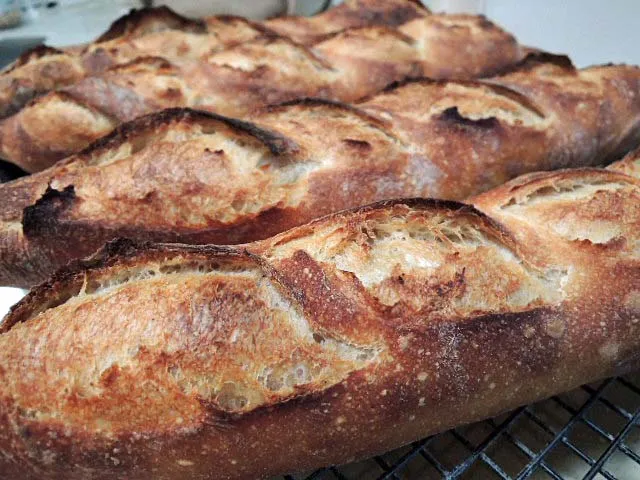
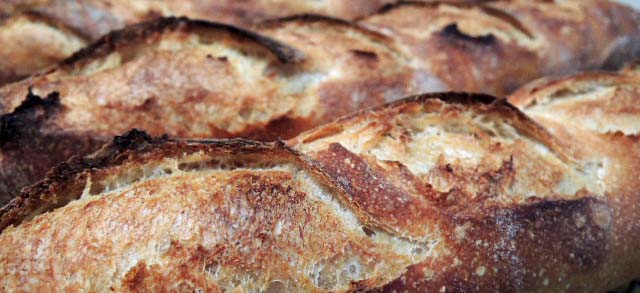
San Joaquin Sourdough Baguettes
April 1, 2013
My San Joaquin Sourdough originated in Anis Bouabsa's baguettes which had won the prize for the best baguette in Paris in 2008. Bouabsa's baguettes departed from convention in utilizing a 21 hour retardation after bulk fermentation and before dividing and shaping. Jane Stewart (Janedo on TFL) and I initially modified Bouabsa's formula by adding a bit of rye flour and some sourdough starter for flavor. I then omitted the commercial yeast altogether and began using the modified formula to shape as bâtards. Over time, I have tweaked the formula and method in various ways, but have settled on the current one as providing the best product.
Today's bake takes the San Joaquin Sourdough back to its roots, so to speak. I used my current formula and method to make San Joaquin Sourdough baguettes. I am very happy with the results.
Total ingredients | Wt (g) | Bakers % |
AP Flour | 479 | 89 |
WW Flour | 33 | 6 |
Medium rye Flour | 29 | 5 |
Water | 392 | 72 |
Salt | 10 | 1.8 |
Liquid starter | 17 | 3 |
Total | 960 | 176.8 |
9.2% of the flour is pre-fermented
Liquid Levain ingredients | Wt (g) | Bakers % |
AP Flour | 29 | 70 |
WW Flour | 8 | 20 |
Medium rye Flour | 4 | 10 |
Water | 42 | 100 |
Liquid starter | 17 | 40 |
Total | 100 | 240 |
Final dough ingredients | Wt (g) |
AP Flour | 450 |
WW Flour | 25 |
Medium rye Flour | 25 |
Water | 350 |
Salt | 10 |
Liquid levain | 100 |
Total | 960 |
Method
Mix the levain by dissolving the liquid starter in the water, then add the flours and mix well. Ferment at room temperature, covered tightly, until the surface is bubbly and wrinkled. (8-12 hours)
Dissolve the levain in the water, add the flours and mix to a shaggy mass. Cover and autolyse for 30 minutes.
Add the salt and mix to incorporate.
Transfer to a clean, lightly oiled bowl and cover tightly.
Bulk ferment for 3-4 hours with stretch and folds in the bowl every 30 minutes for the first 2 hours, then a stretch and fold on the board after 2.5 hours. The dough should have expanded by about 50% and be full of small bubbles.
Refrigerate the dough for 18-24 hours.
Take the dough out of the refrigerator and transfer it to a lightly floured board.
Divide the dough into 4 equal pieces and pre-shape as logs or round.
Cover the pieces and allow them to rest for 60 minutes.
Shape as baguettes and proof for 45 minutes, covered.
Pre-heat the oven to 500ºF with a baking stone and steaming apparatus in place.
Transfer the baguettes to your peel. Turn down the oven to 480ºF. Score the loaves and load them onto your baking stone.
Bake with steam for 10 minutes, then remove your steaming apparatus and continue to bake for another 10-12 minutes. (Note: After 10 minutes, I switched my oven to convection bake and turned the temperature down to 455ºF.)
Remove the loaves to a cooling rack, and cool for at least 30 minutes before serving.

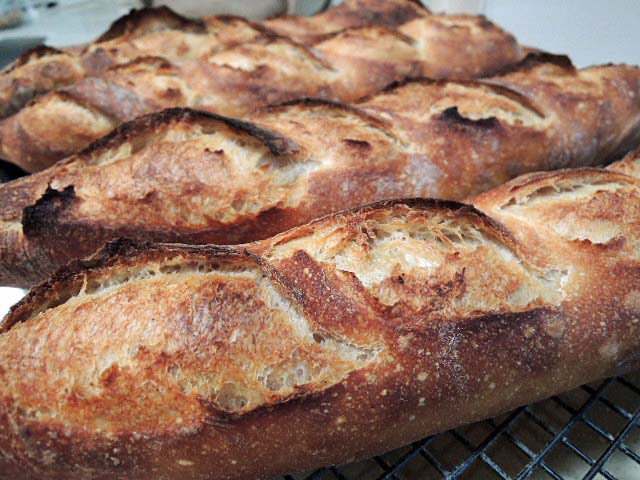
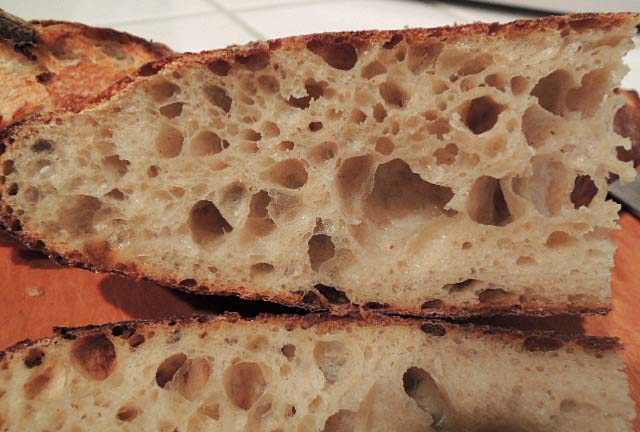
When tasted about 2 hours after baking, the crust was crunchy and the crumb was soft. The flavor was complex, with a caramelized nuttiness from the crust and a sweet, wheaty flavor from the crumb. There was some mild acidity but no discernible acetic acid tanginess. These are among the best-flavored sourdough baguettes I have ever tasted. Very yummy fresh baked and with great sandwich, crostini, toast and French toast potential.
David
Submitted to YeastSpotting
- dmsnyder's Blog
- Log in or register to post comments
Dear David,
I made this as one of my first serious forays into sourdough using my homemade couche, it turned out great, though I'll definitely need to practice shaping baguettes.
Definitely one of the betterbaguettes I've had, and as a bread historian as well as a mediocre baker, that says a lot about the quality of the recipe.
Thanks for the recipe!
Nick
I'm glad you enjoyed these baguettes. As you may already know, the same procedure with various modifications in ingredients and/or shaping can be used to make a variety of equally delicious breads.
Thank you for sharing your experience.
David
lovely recepe. gives a very nice dough! I used 10% less water to compensate for the Dutch flower. However I made the classic beginners mistake to folow the recepe instead of watching the dough. Final proofing shouls have been shorter to get a better ovenspring. But I'm going to try again.
I would love to hear about your experience making SJSD with your local flours, and to see photos!
David
I hate to ask something that is probably completely obvious to every on this forum, but I signed up yesterday and am still a bit of a Newbie. What is 'WW' Flour?
I am very much looking forward to having a go at this recipe, but just want to be sure I know which flours I am to use! AP I assume is the US All Purpose flour and the equivalent to our White Stoneground Strong or Bread flour here in the UK?
David
These look top notch. Think I'll even try in my oval roaster and see what happens.
Hi David, I made a UK version of SJSD baguettes yesterday - my first ever baguettes! As we don't have AP flour nor did I have French flour, I used a mixture 1/3rd to 2/3rds of plain white flour to strong white bread flour. The resulting flavour is tasty but I'm not sure if it was the correct ratio. So the slashing is a bit off, they were a bit 'heavy' and chewy, but still very yummy! However one thing I noticed was that they were split along the baguette on the underneath. Could I ask you for help and/or comments as to what you think caused that and any tips you can give to my baguette making, thanks.
Sorry for the delayed reply. I just saw your message.
First, your baguettes look pretty nice. Of course, I am not familiar with your flours. From the loaves' appearance, I'm guessing that your flour mix results in a higher protein content than my flour which is about 11.5% protein.
Loaves splitting on the bottom usually is along a seam that was not well sealed when the loaf was shaped. However, that doesn't appear to have been of great consequence.
David
Thanks for the reply David, always nice to hear back from an expert. Will try different flour mixes and practice my shaping techniques! :)
Hi David, after when u took out the dough from the fridge did you let it come to room temperature before you divide the dough ? And at what temperature were the dough bench rested and during the final proofing ? Thank you.
Sorry for the delayed reply.
With this bread, the dough is divided and pre-shaped right out of the fridge.
My kitchen temperature varies seasonally but is between 68 and 78 dF, generally.
David
After many days of researching the perfect baguette, reading countless books, and after countless experiments your post has simplified and summarized years of part time research. An indispensable reference, well done.
I'm glad my post was helpful to you! Thanks for letting me know.
Happy baking!
David
Dear David, thank you for the very nice looking recipe, which I am looking very much forward to trying with some old nordic wheat and rye sort flours. I have a quick question about the oven you are using. Here in the Scandinavian counties, our ovens often have two functions: regular with a top and a bottom heater, and 'hot air' where a fan in the back of the oven blows the air around in the oven, among other things making it easier to bake or cook in one than level simultaneously. The hot air function is used in some recipes, but requires the oven to be set 10-20°C lower than when using the conventional oven function, and is especially good if you are cooking food that needs to dehydrate a bit to get done.
Which kind of oven are you using, and would you recommend me to use regular or hot air oven for these baguettes?
Best regards from René from Denmark
Just to correct myself, I meant to write "bake or cook in more than one level simultaneously", an not the nonsense I have written above.
My convection bake = your fan bake.
David
David,
How do you calculate 9.2% of the flour is pre-fermented in your recipe above? I can't make that percentage work from your recipe. I'm thinking TFW = 541g and flour in preferment = 41g, with no accounting for flour contained within the Liquid Starter. I'm trying to learn about percentage of flour pre-fermented. I'm thinking that if the TFW to 1000g and the percentage of flour pre-ferment is 10% then I would use 100g of flour in my preferment. --- Also, should I take into account the flour contained in the Liquid Starter? Where am I missing it?
Lastly does "Liquid Starter" mean the hydration is 100% or what?
Beautiful loaves...
--Dan
Hi, Dan.
Total flour = 540 g (That does include the flour in the starter that fed the levain). Total pre-fermented flour = 50 g. (Rounded to the nearest gram).
"Total" means all of the flour going into the dough. Some is from the mother starter that feeds the levain. Some is the flour mixed along with water and starter to make the levain. Some is the flour added in making the final dough.
All the flour in the levain is pre-fermented.
The term "liquid starter" is not precise. It basically refers to any batter-like starter/levain. In this bread, the levain is 100% hydration. Some of Hamelman's liquid levains are 125% hydration.
Hope that answers your questions.
David
THANK YOU David for this formula! I know this post is a few years old but it brought me here to The Fresh Loaf and I'm grateful.
My first few attempts at natural yeast/levain/sourdough baguettes were big fails and I thought I just didn't have the knack for it. I followed your instructions and wow, I am already mixing up batch #2 before these baguettes are even completely cooled!
Hello, my question is I have been making the baguettes but was wondering if I can just make one loaf instead and also if I can make the baguettes and incorporate Olive Tapenade in and if so when do I incorporate ???
Frances Ann
You can make as much or as little dough as you want. Just keep the proportions the same.
I have made bread with whole pitted olives but never with tapenade. If you try it, let us know how it works. It sounds interesting.
David
David, thanks for this easy recipe that turned out very tasty baguettes and epi today. I have a new WY starter and this was its first no-yeast test. I increased the recipe to 190% to have slightly larger loaves and extras for the neighbor's dinner. It was my 2nd attempt ever at baguettes (the first was poolish), and first time with epi. Dough looked great in the Cambro at each stage. I was a little worried during final proof but put a baguette on the stone, added water to the pan of lava rock, and got lovely oven spring! Baked the rest with nice results. My shaping and scoring need more work, but chewy texture, holes of various size, and great flavor.
David, thanks for sharing this recipe with us.
I tried it yesterday and had a very interesting result. The taste was more complex, adding rye and WW flour, even in those little quantities. Honestly, I didn't expect that. Thumbs up!
I've also, for the first time, got rid of the poolish and I think I won't use it again for a while.
The recipe has been adapted, in order to produce 10 baguettes, 5 for each bake (265-280 gr. each) - 72% hydratation.
Tried also for the first time Milanaise Organic AP Flour (I'm in Montreal) and very happy with the result. Less proteins than the standard flour I used to find. I think it was one of the key for having the right extensibility while shaping.
Here they are ;)
Wow, David,
I just pulled these baguettes out of the oven and they are FANTASTIC! thank you for your wonderful resources! The crumb is wide open, it's creamy, crunchy, a little tangy, and wheaty and I've already eaten an entire baguette by myself! This recipe's a keeper!
Happy Baking!
I am delighted by reports like yours. I really do appreciate you letting me know that this formula worked so well for you.
Note that the same dough makes wonderful bâtards of about 500 g. I have also used it for sandwich rolls - as demi-baguettes.
Ah, well. Your report makes me want to jump up, activate my starter and bake a batch of SJSD baguettes for myself!
David
Hi
Can anyone help me please?
Reading the 'Total Ingredients' in the recipe:
It appears that the flour in the starter is not included in the total flour used to get the 100%.
How can I see the real final hydration is in a recipe presented like this?
I'm sure I'm missing something here.
Please help if you can.
Thanks.
The starter is 100% hydration. That means it is equal parts water and flour. So, since 17g of seed starter was used, 17/2 = 8.5g flour and 17/2 = 8.5g water can be added to the total flour and water respectively. If you wish to recalculate the "real final hydration," have at it. Hint: It's 72.88% which is 0.43% higher than the previously calculated hydration.
David
Hi David
Thanks for comming back.
No, that's great.
I thought I was missing something there.
These loaves are a little above my skill set right now.
I realy enjoy your posts BTW.
Thanks for all of the effort and sharing.
Kevin
David......this looks perfect !!!!
Thanx for sharing ....
Thanks for a great recipe - Works wonders.
Here is my first try at making baguettes :)
I hope you approve... Next time I want to try with spelt rather than rye.
Thanks once again. Tim
Your baguettes look deliciously crusty. Most impressive, especially for a first baguette bake.
Happy baking,
David
For my first attempt in baking these baguettes, I am very pleased with the flavor, crunch and crumb. My baking stone was not as big as I wanted so my baguettes were smaller than I wanted, I need to get a bigger baking stone and instead of cutting this recipe in to four pieces I'll cut it into three or two.
Image
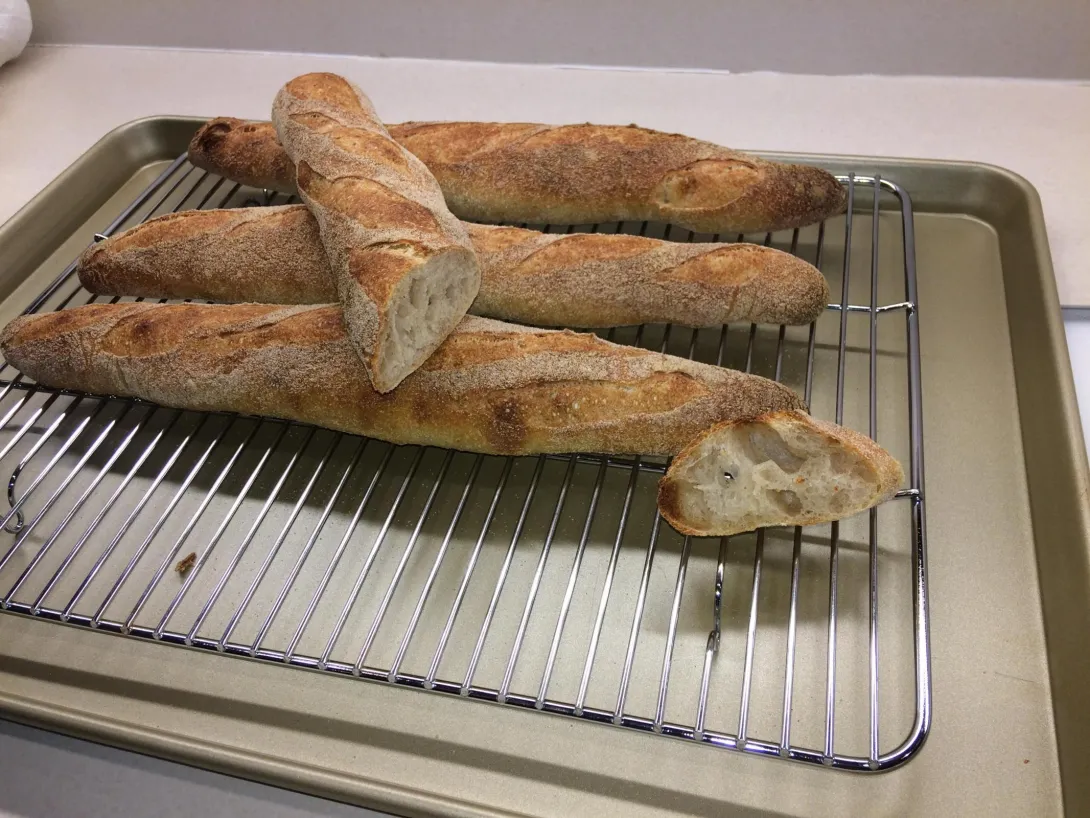
I share your problem with a too small baking stone, but smaller, thinner loaves have some virtues.
Happy baking!
David
I had several failures making baguettes in the past. This is my second attempt at making sourdough baguette, and to my taste, it has turned out perfectly.
Baked on my baking steel. The crust is incredibly thin and light yet super crispy. Crumb is soft and light.
I will be making these on a weekly basis now! Thank you so much!
Thanks for sharing! I'm glad the formula is working so well for you.
Happy baking!
David
Hi David. I love this recipe and have made it in the past but I’m guessing we’re one of the few households in Auckland, New Zealand, enjoying sourdough baguettes regularly given our Covid 19 lockdown. No sooner do we eat them then I am “requested” to make another batch. Can’t ask for a bigger compliment than that.
Hi David. I love this recipe and have made it in the past but I’m guessing we’re one of the few households in Auckland, New Zealand, enjoying sourdough baguettes regularly given our Covid 19 lockdown. No sooner do we eat them then I am “requested” to make another batch. Can’t ask for a bigger compliment than that.
Hi, kiwiv!
We all need compliments and comfort foods to maintain sanity these days! I am honored to be able to provide a vehicle for your family.
Stay safe and healthy!
David
Hi David, tried your recipe and although it did not look like your pictures..the end results were quite good.
not sure what the reasons were, except that I missed the preshaping post 24 hr retardation. I did use more whole wheat 250gms since u was out if AP flour and have a rye starter. Just did not get the exterior shine and drowning...mine stayed lighter in color...
in any case great tasting baguettes and thanks for the recipe!
ck
Novice baker here. I'd love to try this recipe and wonder if I might get some help. Regarding the liquid starter, is that just the sourdough starter that I have, which I should ferment with the other flours? In step 2, one is simply mixing the levain with the ingredients from the final dough ingredients, correct? Also, autolysing is a rest period (is there anything more to it)?
Thank you!
Neil
A liquid starter, in this case, is a starter made with equal weights of flour and water, that is, at 100% hydration. I have no idea what the "sourdough starter that (you) have" is.
When I mix this dough for the autolyse, I dissolve the levain in the final dough water, then mix in the flours. An autolyse is a mix of ingredients without the salt, in this case, to give the flour a chance to absorb the water and start gluten formation. Salt competes with flour for the water and also prematurely tightens the gluten strands.
FYI, when you make a sourdough bread with a firm (not liquid) levain, you hold out the levain as well as the salt until after the autolyse.
David
Hello David. I'm new to baguette making but would like to try your recipe for SJSD Baguettes. In your chart for the "Liquid Levain ingredients", weights for the three flours ( total 41 grams), water (42 grams) and "Liquid starter" (17 grams). What are the ingredients are used to create the 17 grams of "Liquid starter"? Is it the equivalent of a poolish?
The ingredients of the liquid starter are exactly the same as those of the liquid levain. However, if you have a liquid levain made with a different flour mix, it's fine to use it.
A poolish is a pre-ferment that has commercial yeast, not sourdough, and is generally but not always at 100% hydration.
David
I don’t have any starters or levain made since my baguettes, so far, just use flour, instant yeast, salt and water and sometimes diastatic malt powder. Is there somewhere in TFL where I can learn how to make a simple liquid starter levain? Is it just equal amounts of flour and water covered and set aside for x-number of hours at RT or refrigerated for x-number of hours? For instance, for the 17 grams of liquid starter, would it be 8.5 grams of flour and 8.5 grams of water? Thanks for your guidance. I’m not quite ready to commit to and manage a true sour dough starter.
Use the TFL search function. Search the internet. Buy a good book. (Look at the TFL book reviews). Or, if you don't want to maintain a starter, just stick to baking with commercial yeast.
David
Have a look at http://www.thefreshloaf.com/10901/pineapple-juice-solution-part-2 this worked for me a year ago and is a pretty reliable method for creating your own sourdough starter.
Benny
Thank you for sharing this. I think I messed it up in just about every way that I could,. I think I under proofed, then the fire alarm started going off when the oven was preheating and I got distracted and forgot to slash the loaves. Then my worry about the fire alarm continuing to go off every 5 minutes caused me to take them out too early.

It's my worst sourdough try so far. HA! But I'll try again! :)
Hi David,
I have my first batch of this in bulk fermentation right now and happened to find another article with the recipe that shows 370g of water in the dough rather than 350g.
Which works better?
https://www.everopensauce.com/san-joaquin-sourdough-bread/
At various times, I have mixed the SJSD dough with anywhere between 350 to 370 g of water (for 550g total flour). None were bad. These days I most often use 360g, but it's your choice. Lower hydration is easier to handle, if you don't get along with stickier doughs.
David
Hi David,
I am making the Baguettes now - can you explain why you "stretch and fold on the board after 2.5 hours" - its not clear why you take the dough out of the bowl to do this final stretch and fold. I have a large wood pasta board which I will use for this, and shaping.
Thanks
Luke
I think the stretch and fold on the board contributes more gluten strength than the s and f in the bowl. Actually, what I have done for years I see is now called "lamination." This is the approach I use with most of my sourdough breads these days - S&F in the bowl at 30 and 60 minutes after levain and salt have been added, then "lamination" 50-60 minutes later.
David
David, I wanted to share with you my first time baking your San Joaquin baguettes. I generally followed your formula except that I ended bulk fermentation when the dough in my aliquot jar was at 20% rise. The dough went into cold retard for 24 hours and I baked today. Divid and pre-shape, bench rest in loose cylinders for 20 minutes then shape. The dough was much more extensible than I was expecting. I then did a room temperature bench rest en couche for 30 mins and then back in the fridge to chill and firm to make scoring easier.
This was a bit of a disaster, ok maybe that is a bit dramatic, but because of a really boneheaded mistake of mine, it didn’t turn out as well as it might have. What would be a critical thing to miss doing related to the start of baking your baguettes? Steaming, no I remembered that and it was all set up, boiling water poured into the cast iron skillet. Let’s see I loaded the baguettes and they’re in there on the hot baking steel steam doing its thing. Maybe 1.5 minutes into steaming, OMG I didn’t score the baguettes!!! Have you ever wondered what baguettes would look like it you forgot to score them, then took them out, scored them as they were just starting to rise? Now the dough is warm instead of cold after having had them in the fridge for 60 minutes to firm up to score. Opening the oven of course lets the built up steam out.
Anyhow, taking them out to score them compromised the oven spring and thus the ears and grigne. You will be surprised, maybe not as surprised as I was at the crumb though. Surprisingly open.
David thank you for sharing your formula with us here on TFL. I will have another go at this and hopefully not make a big mistake, maybe just my usual small less consequential ones. ; )
In the continuum of errors, you could have done worse. The oven spring looks pretty normal, and the crumb is really nice. How did you like the flavor?
Thanks for sharing!
David
Thanks David, I quite liked the flavour, enough that I ate a whole one myself for dinner last night! I hate these silly errors, fortunately only visual issues resulted, I’m still quite surprised that the crumb turned out so well despite the error. Thanks again for sharing your formula.
Benny
14 weeks after my first home made sourdough loaf, I decided to attempt your San Joaquin baguettes and wow. I was happier at step 3 mixed by hand than any previous loaf. Helps that I have been studying your posts and watched many videos about each step in this process. Wish I could send you a personal note of thanks. lived in France util age 14 where there were still some great old fashioned bakeries in my St Germain des Prés neighborhood. (Including Poilâne...) and as a 6-7 year old I got to try them all and knew my favs. Thank you for giving me the courage to try/make/bake/ follow your generous lead.
Wonderful to hear of your success! Thanks for sharing.
Happy baking!
David
SJSD baguettes are my favorites, thank you for this recipe!
Sometimes I read old posts just to feel good and give me hope in my breadbaking ...especially on days when forget something. Today, I let an 100% rye SD bread over proof.
That said, thank you for your excellent photos and detailed instructions. They bring me joy.
We all need a bit of joy, and it's been harder to find for the past year. So, it makes me happy to have given you some.
David
Wow! I am in love with the baguettes I was able to make with this recipe. Many thanks for perfecting this and sharing your recipe and process. The beautiful crumb and thin, crispy crust are heavenly. I had retarded at the bulk stage. The feel of pre-shaping the cold dough was strange and I was skeptical (I thought at various points that I had done something wrong). I persevered and was so happy that I did. Thanks again!
I appreciate your sharing your enjoyment of the SJSD Baguettes, and I am so happy you do enjoy them.
Happy Baking!
David
Hello David,
Firstly, I'd like to thank you for this recipe. I first discovered it some years back just when I was getting back into baking after a 20-year absence. I even submitted a question regarding flour as I was rather confused by the differences between US and UK terminology, as I recall. Anyway, I have revisited your recipe this past week with two attempts. The first was extraordinarily ordinary, with slightly underwhelming oven spring and very amateur shaping skills coming to the fore.
This second attempt shows signs of improvement in all areas. While the shaping still leaves a lot to be desired, the baguettes are decidedly more round in shape and less 'flatish'. I think this comes from my researching preshaping and tightening up the dough a little more at that stage. This made the final shaping stage a lot easier. I also read through some of the old comments and tried the 300 slap and folds suggested by one commentator, in addition to the bowl folds (which I also mixed in with some Rabaud kneading). One other key difference this time was born out of the curiosity piqued by the description in your recipe of using a combination of yeast and Levain. I had a packet of yeast in the cupboard left over from a recent cake bake by my wife and as I had not used yeast in a few years, I decided to give it a go. I therefore put together a Poolish the night before. To do this, I added together all the weights from your levain and main recipe and calculated a 100% hydration Poolish based on 40% of the flour weights. I used half a packet of yeast (approximately 3 g) and for fun, I experimented with putting in 4 g of salt too. In a separate container, I also put a tsp of my rye-based sourdough starter and a mix of mainly French T55 flour and some Wholegrain (Wholewheat in US money) - approximately 30 g between the two, plus 30 g of tepid water. Both of these I left to mature overnight. The Poolish ended up being very lively indeed and I even lost some over the side (larger bowl needed next time). The levain was rather slower in development. I then dissolved the Poolish in the remaining volume of water from the recipe, added the T55 flour, WW flour and the Dark Rye (that's all I had open at the time). At this point, I also added in most of the 60 g of levain (which more than made up for the Poolish that had made a successful bid for freedom overnight). I then proceeded to follow your recipe to the latter, adding the remainder of the salt after the 30-minute autolyse, at which stage I also did the 300 slap and folds (honestly, quite arduous work and I'm not entirely convinced it improved the quality of the dough to warrant me doing that again). After that I did the folds in the bowl with a quick Rubaud kneading every half hour and then a stretch and fold on the bench after 2.5 hours. I actually streatched the dough out very thin into a very large rectangle at that point and folded both sides to meet in the middle and then the right on top of the left (so a double side fold, in effect) and then rolled down from the top to the bottom to form a sort of roularde. This was popped into a lightly oiled container for final bulk proofing before retardation of 21 hours.
Anyway, here is the end result. I am rather embarrassed by my shaping skills, but the taste of the Poolish/Levain combo is truly magnificent:
...the first photo above is after the preshaping stage as a reminder to myself to tighten the dough a bit at this stage. I also experimented with preshaping into a ball on one of the demi-baguettes.
I also forgot to mention that another tweak I made between the first and second attempt was to bake the demi-baguettes lengthwise in the oven. The reason for this is in the past, when I transfer the baguettes off the peel into the oven sideways, I always seem to get a curve in the baguette. By putting them lengthwise into the oven, you are withdrawing the peel along the length of the baguette and this actually helps to keep it straighter, if anything. It does mean I have to cut the length down to 30 cm, but that is absolutely fine for my needs and works well for 4 x 240 g demi-baguettes with your recipe.
The third, slightly odd-looking baguette is me trying to be fancy and cut ears into the baguette with scissors and moving each ear to alternate sides. My cutting technique really needs work though!
Anyway, thank you again, David. I am now confident enough now to bake Baguettes free-form and do away with the steal baguette trays I have used in the past, which, I feel, are cheating really.
...the crumb
I made this recipe today. I have been baking bread for several years but consider myself novice. First of all, the baguettes are delicious! My problem is that the dough was very stretchy and sticky. When I do the final shape it elongates to a full length on its own. I also think the oven spring is not as good as it could be.
I made some modifications to the recipe. I used excess 100 g of Levain from the Tartine Country Loaf recipe. Its 100% hydration with AP flour but less % starter. Starter was very active. I think the Levain was good, my other loaves turned out very nice. For Flour I used KA Sir Galahad (AP) and whole grain WW & Rye from a local mill. I did 4 S&F for first 2 hours 30 minutes apart but did not do the bench as I didn't understand what that is, but think I do now. Bulk ferment went 4 hours -had in proofer box at 80deg. It expanded just a little under 50% and had lots of bubbles. Overnight in fridge 19 hours. Divided into 3 pieces instead of 4. I have never posted here before -such good bakers on this site.
Image

Image
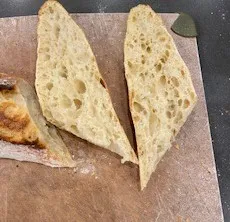
A bit frustrated with the crumb and the oven spring was pretty poor as well..... but the flavor was really nice!
Scoring the dough was also a real struggle...Do you think I could reverse the process and bulk at RT then pre-shape / shape + fridge overnight + baking straight out from the fridge? What would it change??
Thanks :-)
Hi, Gail.
Your baguettes don't look so bad to me. The possible causes of a less open crumb and less oven spring are many. It's a bit hard to tell from your photos, but the crumb suggests under-fermented dough. The oven spring doesn't look poor from what I can see.
Have you seen my scoring tutorial? It may help with that issue.
You could retard formed loaves rather than retard before dividing. The bread would probably be good, but it's not the same bread.
Wish I could offer more definitive advice.
David
Thank you very much for your prompt reply, I really appreciate it
I'll try to adjust the fermentation next time, thanks again David!
Hello David, a great recipe.
What day time and night time temperatures are you making this recipe at? I live in Malaysia where the day temperature is 32-35C (90-95F) and night temperature is 30C (86F) or 26C (78F) in the aircon.
I guess I am going to modify the timings and maybe use less liquid starter to deal with the high temperature.
Thanks
The kitchen temperature here varies with season from about 65ºF in Winter to 78ºF in Summer. I do use a Proofing Box. I generally set it at 76ºF for levain ripening and 80ºF for bulk fermentation.
For much warmer kitchen temperatures you have a few options: You can decrease the levain inoculation, as you suggest. You can also refrigerate ingredients before mixing, even the flour. Think of ways to achieve an ideal dough temperature after mixing of 76-78ºF. Using iced water in mixing the dough is probably the simplest. You can also put your dough rising container in a cool water batch.
Other bakers with experience in tropical baking may chime in.
Happy baking!
David
Thanks for your reply David.
Yes quite a few possibilities there.
Since moving from the UK ten years ago to Malaysia, it has really messed with my normal bread making techniques.
Most of the recipes available online tend to be for non-tropical areas. The only bread available where I live in Malaysia is the mass produced factory cut bread which tends to be very sweet, so baking my own is must.
Thanks again for your suggestions
Higgs
This is without a doubt one of the very best methods I’ve found in many years of practicing the dark art of sourdough bread. Bravo, sir. We are all in your debt.
Superbes baguettes, recette adoptée, pas d'acidité exacerbée, belle mie et croûte bien craquante, un régal
Thank you for this recipe! I'm a relatively new baker, and recently got into baguettes - something about a nice baguette coming out of the oven and tasting good is just so rewarding. I started a starter recently and was excited to use it, but had no idea where to begin. Stumbled on your recipe and made some of these the other day and they turned out excellent! I omitted the rye flour as I didn't have any, but am excited to try again with that added for the additional flavor. Thanks again! Your loaves look beautiful.
I'm happy this pleased you!
Happy baking!
David
It's still a favorite!
David